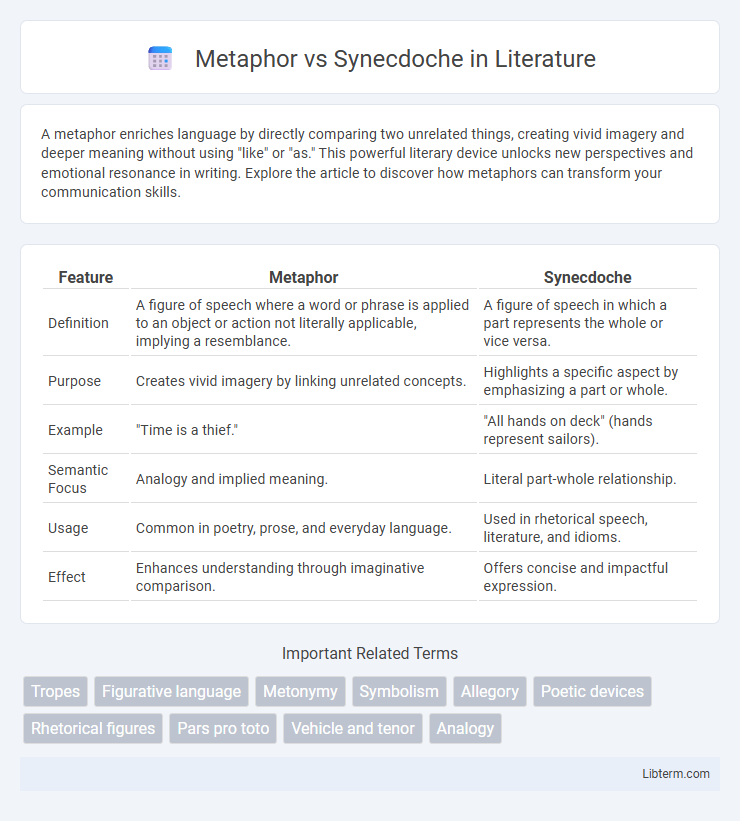A metaphor enriches language by directly comparing two unrelated things, creating vivid imagery and deeper meaning without using "like" or "as." This powerful literary device unlocks new perspectives and emotional resonance in writing. Explore the article to discover how metaphors can transform your communication skills.
Table of Comparison
| Feature | Metaphor | Synecdoche |
|---|---|---|
| Definition | A figure of speech where a word or phrase is applied to an object or action not literally applicable, implying a resemblance. | A figure of speech in which a part represents the whole or vice versa. |
| Purpose | Creates vivid imagery by linking unrelated concepts. | Highlights a specific aspect by emphasizing a part or whole. |
| Example | "Time is a thief." | "All hands on deck" (hands represent sailors). |
| Semantic Focus | Analogy and implied meaning. | Literal part-whole relationship. |
| Usage | Common in poetry, prose, and everyday language. | Used in rhetorical speech, literature, and idioms. |
| Effect | Enhances understanding through imaginative comparison. | Offers concise and impactful expression. |
Understanding Metaphor: Definition and Examples
Metaphor is a figure of speech that directly compares two unrelated things by stating one thing is another, creating a symbolic meaning beyond the literal. Common examples include "Time is a thief," which conveys the idea of time taking away moments unnoticed. Understanding metaphors enhances language comprehension by revealing deeper connections and emotional nuances in communication.
What is Synecdoche? Key Features Explained
Synecdoche is a figure of speech where a part represents the whole or the whole represents a part, such as using "wheels" to refer to a car. Key features include its reliance on a tangible, concrete element to symbolize a broader concept and its frequent use in literature and everyday language to create vivid imagery. Unlike metaphor, which compares two unrelated things for rhetorical effect, synecdoche directly links a component to its entire entity, enhancing clarity and emphasis.
Origins and Historical Evolution of Metaphor and Synecdoche
Metaphor originated in ancient Greek rhetoric, with figures like Aristotle defining it as a linguistic device that transfers meaning based on resemblance, deeply rooted in classical literature and philosophy. Synecdoche, also stemming from Greek origins, evolved as a figure of speech where a part represents the whole or vice versa, gaining prominence in Roman and later medieval texts. The historical evolution of metaphor expanded through Renaissance poetry and modern cognitive linguistics, while synecdoche maintained its significance in rhetorical traditions and literary analysis.
Structural Differences Between Metaphor and Synecdoche
Metaphor operates by transferring meaning from one concept to another based on similarity or analogy, creating an implicit comparison that connects unrelated ideas. Synecdoche functions through a part-to-whole or whole-to-part relationship, where a component or a broader category represents the entire entity or vice versa. Structurally, metaphors depend on associative parallels, while synecdoches rely on quantitative or hierarchical relationships within the referent.
Functions and Uses in Literature
Metaphors function as figurative devices that create direct comparisons between unrelated concepts, enriching literary imagery and evoking deeper meaning by appealing to readers' imagination. Synecdoche operates by substituting a part for the whole or vice versa, enhancing specificity and aiding in concise, evocative descriptions that ground abstract ideas in tangible elements. Both devices are pivotal in literature for symbolism and thematic emphasis, shaping narrative tone and facilitating layered interpretations.
Common Examples in Everyday Language
Metaphors often appear in everyday phrases like "time is a thief" or "the world is a stage," where one concept symbolically represents another. Synecdoche is commonly found in expressions such as "all hands on deck" (using "hands" to represent sailors) or "lend me your ear" (ear representing attention). Both figures of speech enrich language by creating vivid imagery, but metaphors convey analogy broadly while synecdoche substitutes a part for the whole or vice versa.
Metaphor vs Synecdoche: Comparative Analysis
Metaphor and synecdoche are both figures of speech that create meaning through association but differ fundamentally in their mechanisms; metaphor involves describing one thing as another to highlight shared qualities, while synecdoche uses a part to represent the whole or vice versa. In literary analysis, metaphors expand interpretative layers by linking disparate concepts, whereas synecdoches ground expressions in concrete, tangible elements that symbolize broader ideas. Understanding the contrast between metaphor's conceptual substitution and synecdoche's representational shorthand enhances comprehension of narrative and poetic techniques.
Impact on Reader’s Interpretation and Emotional Response
Metaphors create vivid imagery by linking unrelated concepts, enabling readers to grasp abstract ideas emotionally and intellectually, often evoking deep personal reflection. Synecdoche, by using a part to represent a whole or vice versa, grounds the text in concrete specifics, enhancing immediacy and relatability, which intensifies the reader's connection to the subject. Both devices influence interpretation but metaphors broaden conceptual understanding while synecdoches sharpen focus and emotional engagement through tangible details.
Role in Modern Communication and Media
Metaphor enhances modern communication by enabling abstract concepts to be conveyed vividly through symbolic language, making complex ideas more relatable and memorable in media storytelling. Synecdoche functions by using a part to represent the whole, effectively creating concise and impactful narratives in advertising, journalism, and social media. Both rhetorical devices are crucial in shaping audience perception and engagement by simplifying information while enriching contextual meaning.
Tips for Effectively Using Metaphor and Synecdoche
When using metaphor, select vivid imagery that closely relates to the concept to create clear and impactful comparisons, enhancing reader understanding and engagement. For synecdoche, ensure the part you highlight represents the whole accurately and contextually to avoid confusion and add depth to your narrative. Balancing creativity with clarity in both literary devices strengthens your communication and resonates more profoundly with your audience.
Metaphor Infographic

 libterm.com
libterm.com